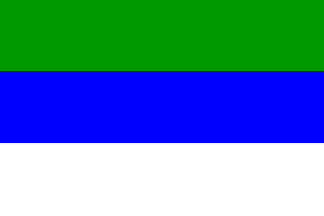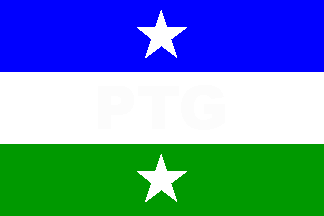
Last modified: 2006-12-09 by antónio martins
Keywords: araucania | patagonia | new france | nouvelle france | adventurer | touneins (antoine-orllie de) | ptg | star: 5 points (white) |
Links: FOTW homepage |
search |
disclaimer and copyright |
write us |
mirrors

Araucania is in Southern Chile. Patagonia is in Southern Argentina. In
the XIX century these lands were not inhabited by europeans and only
native people lived there. After 1861, Chile occupied
the South, and around 1880 Argentina too.
Jaume Ollé, 26 May 1998
In November 17, 1860, a French adventurer named Antoine-Orllie de Touneins (where "Antoine-Orllie" is a composite first name and "Touneins" the family name, changed to "de Touneins" after Antoine obtained it by trial) proclaimed, with the support of the local chiefs, the foundation of a constitutional hereditary monarchy in Araucania (to the which later was added Patagonia). The Kingdom of Araucania (later on Kingdom of Araucania and Patagonia, November 20, 1860) had a real existence of a year and a half. The king took the name of Orllie-Antoine I (modifying Oréllie to Orllie). Chile relinquished the kingdom January 5, 1862.
A new attempt of the king permitted the reappearance of the kingdom between 1869 and 1871. The monarch attempted to return to his kingdom in 1874 and 1876 (then, the kingdom is named Nouvelle France, =New France), without success, returning to France in 1867, where he died in September 19, 1878. His successor maintained the title in exile.
The colours of the flag of the kingdom were nominated by Orllie-Antoine already before his self-proclamation, and it was later on used by the Araucanian tribes that recognized it in Assemblies. Each monarch had their own coat of arms, but only that of Orllie-Antoine can be considered as coat of the kingdom, since only he exercised an effective government.
Sources: El Reino de Araucania y Patagonia by Armando Braun Menández (Editorial Francisco de Aguirre, Buenos Aires and Santiago de Chile). Include various stamps, seals, decorations and shields of the monarchy.
Jaume Ollé, 12 Jun 1996

The flag is, according The Flag Bulletin
[tfb], Braun
Menendez, and other sources, blue, green and white,
but is also published in several bulletins blue, white
and green.
Jaume Ollé, 23 May 1998
I believe that the green - blue - white flag was only
hoisted by Oreille in Araucania for some weeks. Later the
flag was changed in the exile of France and continues
currently in use. I believe that the current arrengement
was adopted later (in Europe) to make the flag
heraldically correct. The info about the original
flag can be found in articles by Lucien Philippe in
The Flag Bulletin [tfb]
and in the book El Reino de Araucania y
Patagonia by Armando Braun Menendez.
Jaume Ollé, 19 May 1999 and 05 Sep 1998
Tounens and Patagonia have been popularized in France by the writer
Jean Raspail: his books on Tounens and Patagonia are fairly impressive and
Raspail created a kind of cult of Tounens and his Patagonian dreams. It is
said that Tounens’ tomb, located in a small village in the south-west of
France, is always decorated with blue, white and green flowers and ribbons.
Patagonian car stickers are common.
Ivan Sache, 2003 Jun 16

Drawn after a sticker seen on a French car this afternoon in Versailles
(France). The flag is horizontally divided blue-white-green with a white
star in the middle of the blue and green stripes and the letters
"PTG" in black. The colours are those of Tounens’
Kingdom of Patagonia; PTG is the “proposed” car code for
Patagonia. Patagonian car stickers are common (in France), but it is the
first time that I see such a sticker with stars.
Ivan Sache, 2003 Jun 16

In the decorations that ran in the “reign”
of the second king (Achilles I), the colours are shown in vertical
position and with five stripes (from the shaft: blue, white, green,
white, blue). This is in fact a medal ribbon, and not a flag.
Jaume Ollé, 23 May 1998 and 12 Jun 1996
Anything below this line was not added by the editor of this page.